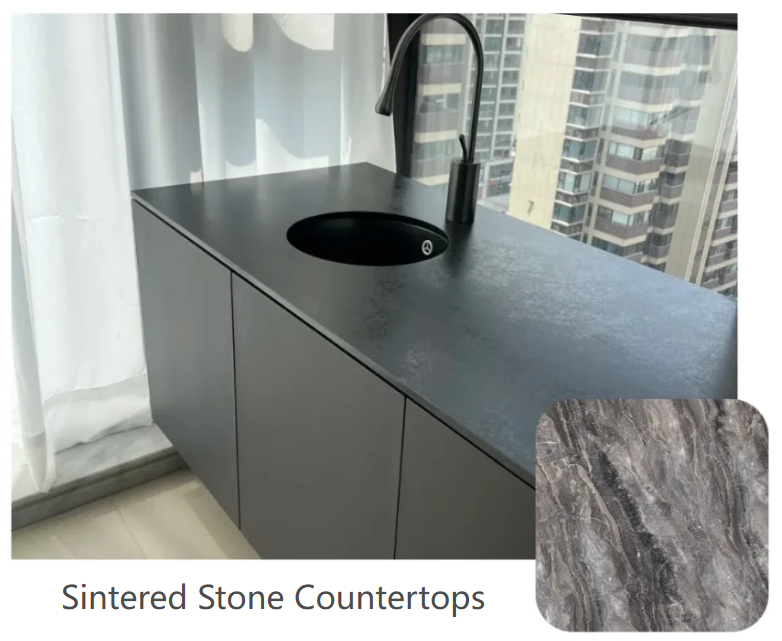When it comes to whole - house customization, the key to achieving both aesthetic appeal and practicality lies in the selection of materials for door panels, cabinets, and countertops. Different materials have their own unique advantages, disadvantages, and suitable scenarios. Let's take an in - depth look at these materials to help you effortlessly choose the most suitable customization solutions for your home! 1. Cabinet Materials: The "Sturdy Fortress" for Storage
1. Cabinet Materials: The "Sturdy Fortress" for Storage
Cabinets form the core framework of whole - house customization, shouldering the heavy responsibility of daily storage. Thus, the durability and environmental friendliness of the materials are of utmost importance.
Particle Board: The king of cost - effectiveness, made by pressing wood chips. It has a flat surface, making it easy to apply various finishes. However, it has relatively weak moisture resistance and nail - holding power, making it suitable for cabinets in dry areas, such as bedroom wardrobes
Multi - layer Solid Wood Board: Composed of multiple layers of thin wood slices arranged crosswise and pressed, it features a stable structure and excellent moisture - proof performance. It's the ideal choice for cabinets in damp areas like kitchens and bathrooms, though it comes at a relatively higher price.
Oriented Strand Board (OSB): With superior environmental performance, often manufactured using oriented structural particleboard technology, it boasts high strength and strong nail - holding power. It's perfect for families with high environmental protection requirements. However, its rough surface requires finishing treatment.
Solid Wood Board: Naturally environmentally friendly with an excellent texture, but it comes with a high price tag. Moreover, it's prone to deformation due to temperature and humidity changes, making it suitable for users who pursue high quality and are willing to take meticulous care of it.


 2. Door Panel Materials: The "Face" Determining Home Aesthetics
2. Door Panel Materials: The "Face" Determining Home Aesthetics
Door panels directly influence the visual effect of whole - house customization, so both aesthetics and practicality should be considered when choosing them.
Veneer Door Panels: By applying decorative paper or wood veneer to the base material, a wide range of textures and colors can be simulated. They are versatile in style and moderately priced, making them a popular choice among the public.
PET Door Panels: These panels have a delicate surface texture and good gloss. They are wear - resistant, scratch - resistant, and easy to clean, often used in modern minimalist - style homes to create a high - end look.
Lacquered Door Panels: With a smooth, mirror - like surface and vibrant colors, they offer high aesthetic value. However, they are vulnerable to bumps and come at a relatively high cost, requiring careful handling in daily use.
Molded Door Panels (PVC): Using medium - density fiberboard as the base material, the surface is formed through vacuum thermoforming or one - piece seamless film pressing. They offer rich shapes and can create various intricate European - style carvings. However, aging and color fading may occur over time.
Solid Wood Door Panels: Crafted from natural wood, they feature unique textures and a warm, gentle feel, with excellent environmental friendliness. But they are expensive and require regular maintenance to prevent cracking and deformation.


 3. Countertop Materials: The "Practical Arena" in Kitchens and Bathrooms
3. Countertop Materials: The "Practical Arena" in Kitchens and Bathrooms
Countertops are areas of high - frequency daily use, so the materials need to be wear - resistant, stain - resistant, and easy to clean.
Quartz Stone Countertops: Made by mixing quartz crystal particles with resin and pressing, they have high hardness, are resistant to scratches and abrasion, and are not prone to staining. They are a popular choice for kitchen countertops, available in a wide variety of patterns to suit different styles.
Sintered Stone Countertops: A new type of high - end material, it is resistant to high temperatures, acids, and alkalis, and has zero water penetration. It offers an advanced texture and can achieve ultra - thin designs, suitable for users who pursue a minimalist style and high - quality living. However, it is relatively expensive and difficult to process.
Marble Countertops: With beautiful natural textures, they can enhance the elegance of the space. But they have low hardness, are easily scratched and stained, and require regular protective treatment. They are suitable for kitchens with low usage frequency or decorative countertops.
Artificial Stone Countertops: They can be seamlessly joined, allowing for flexible shaping and the creation of unique curved or irregular designs. However, they have relatively low hardness and are prone to scratching.
Stainless Steel Countertops: Scratch - resistant, antibacterial, and easy to clean, they are affordable and commonly used in commercial kitchens or industrial - style home decor. However, they have a relatively cold visual texture and are prone to water stains and scratches.


 Matching Suggestions: Combine According to Needs for an Ideal Home
Matching Suggestions: Combine According to Needs for an Ideal Home
Limited Budget: Choose particle board for cabinets, veneer door panels, and quartz stone countertops to balance practicality and cost - effectiveness.
Quality - Oriented: Opt for multi - layer solid wood boards or OSB for cabinets, PET or solid wood for door panels, and sintered stone for countertops to create a high - end feel.
Special Requirements: For damp kitchen areas, use multi - layer solid wood boards for cabinets. If you prefer an open - concept kitchen, choose highly stain - resistant sintered stone or quartz stone countertops. To display collectibles, consider glass door panels.
There is no one - size - fits - all answer when it comes to selecting materials for whole - house customization. By comprehensively considering your budget, usage habits, and decoration style, you can create the most suitable combination. If you have any questions about material selection, feel free to leave a message and let's work together to create your dream home!













